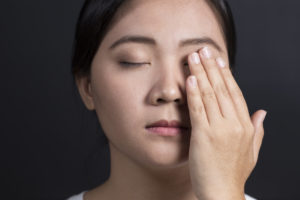What causes headaches?
Headaches are caused by a wide range of things that depend on what type of headache you’re experiencing. Generally, stress can cause headaches if you’re overexerting yourself or in a highly emotional state. There are also many medical reasons for a headache like high blood pressure, or some kind of injury. The brain is connected to the neck and spine, so sometimes when these are impacted by an injury they can lead to headaches. Concussions, or an impact to the head, can also cause persistent headaches over time that may not go away. Not as commonly headaches are the result of a serious illness that may require emergency care. If you have persistent headaches it’s never a bad idea to check with your doctor to rule out anything serious, and have a guided headache treatment plan. So what are the different types of headaches?
 Types of Headaches
Types of Headaches
Headaches are pretty common, and nearly everyone experiences headaches atleast once in a while. However, the way a headache feels isn’t always the same, and the causes can be vastly different, which is what separates headaches into different types. The most common types of headaches include tension headaches, sinus headaches, cluster headaches and migraine headaches.
Tension Headache
Tension headaches is the most common type of headache, and the range of pain it can cause can go from mild to intense behind the eyes and head / neck. The type of pain a tension headache is said to feel like a tight band around the forehead, and most commonly occur only one to two times a month. They’re caused by muscle contractions in the head and neck, which can in turn be caused by types of foods, staring at a computer screen or driving for a long time the cold, or even alcohol. There are many more causes of tension headaches such as fatigue, smoking, a cold, caffeine, poor posture, and lack of sleep. As you can see there are plenty of ways to get a tension headache, which is why they are the most common kind of headache.
The symptoms of a tension headache are usually mild to moderate, though they can become intense. You’d feel a dull pain in your head and pressure around the forehead, with some slight tenderness in the forehead area as well. If the pain is intense with a tension headache it can be confused with a migraine headache, but some of the symptoms of a migraine aren’t present with tension headaches like nausea.
Sinus Headache
Another common type of headache that millions of people experience a year is a sinus headache. Your sinuses are behind the bridge of your nose, cheekbones and forehead, but when they become inflamed due to allergic reaction or infection, the pressure from sinus blockage can cause a pain that feels like a headache. The symptoms of a sinus headache are slightly different than a tension headache or other types of headaches though. You’ll have a deep and constant pain throughout your sinus cavities, meaning your forehead, bridge of the nose, and cheekbones. There are other associated symptoms that can also show up like a runny nose, fever, swelling in the ears and a fullness in your ears.
Your doctor will be able to tell if you have a sinus headache based on your symptoms and physical exam, since you may think you have a tension headache or a migraine. If you have an infection the goal will be to treat your infection to resolve your sinus headache symptoms. Antibiotics, antihistamines or decongestants may be useful in treating your symptoms. Pain relievers are also helpful to manage the headache pain. At home you’ll want to drink plenty of fluids and only take your doctor’s recommended dosage of medication, because taking too much can make your headaches worse.
Cluster Headache

Cluster headaches happen in cluster periods and can come and go over a lifetime with remission lasting for months or years. However, when they happen they can last weeks or months and can be one of the most painful headaches. Cluster headaches are more rare than the other types of headaches and aren’t life threatening, plus there are effective treatment options to reduce the amount of cluster headaches you experience. The most common symptoms of a cluster headache are intense pain behind one eye that possibly radiates to the face, head and neck. It’s generally a one-sided pain and may cause redness of the eye, tearing up, runny nose, swelling around the eye and possibly drooping eyelid.
Cluster periods can be consistent, such as seasonal cluster headaches, with episodes that last anywhere from a week to a year, then remission for up to a year. Headaches occur every day and last between 15 minutes and 3 hours, often at the same time every day. Much of the time the headaches will happen at night after you go to bed. There is no known cause of cluster headaches, but due to the regularity and patterns they follow this suggests it has to do with the body’s biological clock. They aren’t associated with food, hormonal changes, or stress, but can be made worse by alcohol during a cluster period.
Migraine Headaches
Everyone has heard of a migraine headache, but not everyone experiences them. They are a strong headache that many times comes with nausea, sometimes vomiting and a strong sensitivity to light. They last just a few hours, or a couple days, and everywhere in between for different people. Before the migraine proper comes about there is a period beforehand called the prodrome. In this period you may notice sensitivity to light, sound or smell, fatigue, mood changes, thirst, bloating, constipation / diarrhea and possibly food cravings or lack of appetite.
Migraine aura symptoms begin in your nervous system and typically involve your eyesight. You may see black dots, lines, or flashes of light as well as tunnel vision. You might experience tingling or numbness on one side and unable to speak clearly, as well as ringing in the ears. These symptoms usually last less than an hour and come on gradually. Once the migraine attack starts it grows from a dull ache to a throbbing pain and you feel it in one side of the head, but can move to the other or the entire head. They last about 4 hours, but if you have a severe migraine it can go on for days. The frequency of the migraines is also sporadic based on the individual experiencing them, since some people get them every few days while others just a couple times a year.
 Like cluster headaches there isn’t a fully known cause of migraine headaches, but it seems to be related to changes in your brain and possibly when overactive nerve cells send out signals to your trigeminal nerve, which is responsible for sensation in your head and face. Migraines don’t cause any lasting damage though, and your symptoms can be managed with medication and trying some lifestyle changes to reduce stress or improve sleeping habits can help.
Like cluster headaches there isn’t a fully known cause of migraine headaches, but it seems to be related to changes in your brain and possibly when overactive nerve cells send out signals to your trigeminal nerve, which is responsible for sensation in your head and face. Migraines don’t cause any lasting damage though, and your symptoms can be managed with medication and trying some lifestyle changes to reduce stress or improve sleeping habits can help.
Testing for Headaches
Medical history is important when diagnosing what kind of headache you have, or what the root cause of head pain might be. It’s important to rule out any serious medical conditions before moving on to treat headache symptoms and manage the flare ups. Frequency, severity and location initially help differentiate the types of headaches, whether they’re tension, migraine, cluster, or sinus. Your doctor also performs a neurological exam that tests your reflexes to further explore what the cause of your head pain could be. Imaging tests can be used if your doctor suspects the symptoms may be from something more than just a migraine or tension headache, but they will not tell you anything more about any of the headaches we’ve discussed here. CT scans and MRI’s can detect more serious issues like a tumor, aneurysm or some other kind of head trauma injury.
 How to Get Rid of Headaches?
How to Get Rid of Headaches?
As you may know there are plenty of over the counter pain reliever options when it comes to headaches. OTC options such as Tylenol, Advil, Aleve and aspirin are helpful in dealing with the pain of a headache, and are an effective tool when undergoing a particularly bad headache. Doctors can also prescribe prescription strength doses of the OTC medications like ibuprofen and naproxen. For migraines there are medications called acute, abortive or rescue medications that include aspirin and ibuprofen but also prescription medications called triptans and a new kind of drug called CGRP receptor antagonists.
Triptans stimulate serotonin to reduce inflammation and constrict blood vessels which stops the migraine attack. CGRP receptor antagonists are an alternative to triptans for people who don’t find relief in them, or can’t take them for medical reasons. They block the binding of CGRP, which is a protein in the brain involved in the transmission of pain.
Everyday changes that can help relieve headaches are little things like drinking more water. Chronic dehydration can contribute to tension headaches and migraines, and some studies say up to 75% of people inthe US have chronic dehydration. Limiting alcohol intake can help also, though not a direct cause of migraines it can trigger them and also cause other kinds of headaches like tension and cluster.


